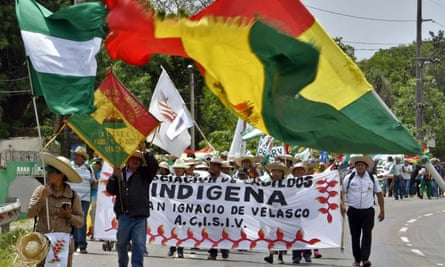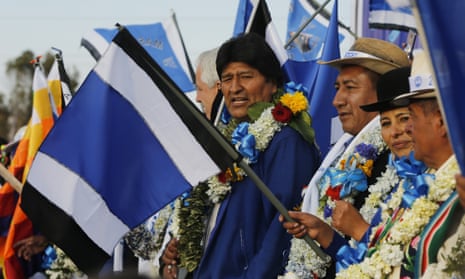Early every morning Juanita Flores walks ten minutes down a newly paved road to climb onto a sparkling new cable car that whisks her to her job selling vegetables in a renovated market in the centre of Bolivia’s capital.
“I get here in half the time it used to take me,” she says, “and in the rainy season I don’t have to slosh through mud anymore.”
On her walk she passes a refurbished school and several multi-story new buildings, all with sewage systems and running water. She and her husband, who owns a minibus, are gradually buying their own home. “I never dreamed we would be able to buy a house,” she says.
Such changes are evident everywhere across Bolivia, the work of a government that has invested profits from a commodity boom into infrastructure and social programs.
But as the 20 October national elections approach, enthusiasm for this government is tempered by ambivalence. The president, Evo Morales, is seeking an unprecedented fourth term after 13 years in power, and in a country with long periods of authoritarian rule, the possibility of another re-election makes many nervous.
“It’s true that Evo’s been in power too long,” said hotel worker Juan Rivero in Santa Cruz. “But at the same time, this government has done a lot for us.”
Until recent disastrous wildfires, it seemed likely that Morales’ re-election was inevitable. But the slow government response to the fires which devastated more than 4m hectares (9.9m acres) of forest and arable land provoked large demonstrations in the cities of Santa Cruz, Cochabamba and La Paz in early October.
Protesters also expressed anger over Morales’s efforts to remain in office, despite a previous pledge to leave at the end of his third term as stipulated by Bolivia’s 2009 constitution. That commitment came immediately after he narrowly lost a February 2016 referendum his government called on whether he could stand again.
A year and a half later, the country’s Supreme Electoral Tribunal – chosen by a legislative assembly dominated by Morales’ party – ruled that denying his candidacy was an infringement of his human rights.

“If Evo wins, that’s the end of democracy in Bolivia,” said telecommunications clerk Gabriel Villegas, 34, who joined the Cochabamba demonstrations.
Morales is modern Latin America’s first indigenous president, a charismatic leader who rose to power from humble origins.
Under his government, political participation and representation by indigenous peoples and women has grown. Bolivia now has the world’s second highest number of female legislators and 36 indigenous languages are now officially recognized.
“Democracy has two faces in Bolivia,” explains political scientist Fernando Mayorga. “Undoubtedly, there has been a concentration of power in the government’s party, but representative capacity and citizen participation have also expanded.”
Morales’ rivals, drawn from the fragmented center-to-right opposition, have taken advantage of public outrage over the fires. A poll ten days before the election showed former president and vice-president Carlos Mesa’s projected share of the vote had risen to 26.9% while Evo’s has dropped to 36.2%.
But – in a reflection of the fluidity of the race – a subsequent poll showed 40% for Morales to Mesa’s 22%. Without a majority, the candidate with the most votes must win 40% of the vote with a 10-point margin to prevail in the first round.
The narrowing gap between Morales and Mess indicates that a runoff is a strong possibility.
Much depends on the most unpredictable voting segment: urban youth. Half the population is under 25, and they are more urban, educated, and middle class than their parents’ generation. Most of them have never known any government except one led by Evo.
Key to Morales’ ongoing support are the pragmatic economic policies that have made Bolivia the regional leader in economic growth, despite the collapse of the commodity boom in 2014. From 2006 to 2018, GDP per capita grew from $1,000 to over $3,600, according to the Inter-American Development Bank.
But how long the economic good times will continue to roll is unclear however.

The country has an alarming budget deficit close to 8% of GDP, the region’s highest after Venezuela and Suriname, and a rising external debt. “The current level of expenditure is unsustainable going forward,” said economist Javier Arevilca.
Government investment has grown three-fold thanks to a huge infusion of funds after Bolivia signed its most favorable contracts ever with foreign hydrocarbons multinationals in 2006. This outlay fueled an economic boom. Brand-new construction and cars, bustling markets and conspicuous consumption have flourished like never before.
The minimum wage gradually doubled in constant terms (even though enforcement is scant) and the government mandated two year-end bonuses (instead of the usual one), stipulating that 15% of it be spent on locally-made goods.
Conditional cash transfers, adopted widely throughout Latin America, have delivered a small stipend to the elderly, pregnant women and children who remained in school, contributing to cutting of overall poverty in half.
“It’s not enough to live on,” said an elderly Cochabamba man, “but my wife gets it too and it covers our food costs. That’s a big help.”
The funding for these programs stems from expanding mining, hydrocarbons exploration, soy production and cattle ranching – often financed by Chinese state capital.
As a consequence, deforestation in eastern Bolivia has doubled since 2015, driven largely by growing cattle raising and soy production.
Over its 13 years in power, Morales’ government has moved steadily towards the center with little programmatic differences between it and the opposition. Pro-Morales election billboards promise “a secure future” foregrounding stability rather than the profound change he originally pledged.
Juanita Flores, the vegetable-seller from La Paz voted for Evo in past elections, but this time she’s not sure who she’ll choose. “I worry that his government is becoming more corrupt – and that he’s been in power too long,” she said.
